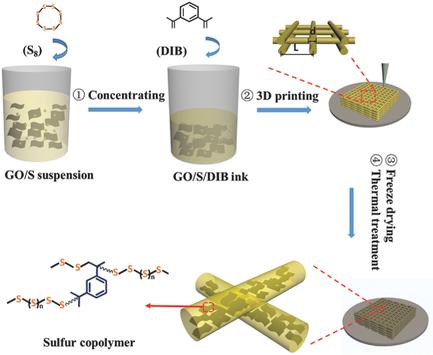当前位置:
X-MOL 学术
›
Adv. Energy Mater.
›
论文详情
Our official English website, www.x-mol.net, welcomes your
feedback! (Note: you will need to create a separate account there.)
3D Printing Sulfur Copolymer‐Graphene Architectures for Li‐S Batteries
Advanced Energy Materials ( IF 24.4 ) Pub Date : 2017-09-14 , DOI: 10.1002/aenm.201701527 Kai Shen 1 , Hailong Mei 1 , Bin Li 1 , Junwei Ding 1 , Shubin Yang 1
Advanced Energy Materials ( IF 24.4 ) Pub Date : 2017-09-14 , DOI: 10.1002/aenm.201701527 Kai Shen 1 , Hailong Mei 1 , Bin Li 1 , Junwei Ding 1 , Shubin Yang 1
Affiliation

|
3D printing is becoming an efficient approach to facilely and accurately fabricate diverse complex architectures with broad applications. However, suitable inks and 3D print favorable architectures with high electrochemical performances for energy storage are still being explored. Here, sulfur copolymer‐graphene architectures with well‐designed periodic microlattices are 3D printed as a cathode for Li‐S batteries using a suitable ink composed of sulfur particles, 1,3‐diisopropenylbenzene (DIB), and condensed graphene oxide dispersion. Using thermal treatment, elemental sulfur can be reacted with DIB to produce sulfur copolymer, which can partially suppress the dissolution of polysulfides. Moreover, graphene in the architecture can provide high electrical conductivity for whole electrode. Hence, 3D printed sulfur copolymer‐graphene architecture exhibits a high reversible capacity of 812.8 mA h g−1 and good cycle performance. Such a simple 3D printing approach can be further extended to construct many complex architectures for various energy storage devices.
中文翻译:

用于Li‐S电池的3D打印硫共聚物石墨烯架构
3D打印正在成为一种简便,准确地制造具有广泛应用的复杂结构的有效方法。然而,仍在探索具有高电化学性能以用于能量存储的合适的油墨和3D打印有利的体系结构。在这里,采用合适的油墨由硫颗粒,1,3-二异丙烯基苯(DIB)和缩合的氧化石墨烯分散液组成的3D打印,将具有精心设计的周期性微晶格的硫共聚物-石墨烯体系结构作为Li-S电池的阴极进行3D打印。通过热处理,元素硫可以与DIB反应生成硫共聚物,硫共聚物可以部分抑制多硫化物的溶解。此外,体系结构中的石墨烯可以为整个电极提供高电导率。因此,-1和良好的循环性能。可以进一步扩展这种简单的3D打印方法,以构造用于各种能量存储设备的许多复杂架构。
更新日期:2017-09-14
中文翻译:

用于Li‐S电池的3D打印硫共聚物石墨烯架构
3D打印正在成为一种简便,准确地制造具有广泛应用的复杂结构的有效方法。然而,仍在探索具有高电化学性能以用于能量存储的合适的油墨和3D打印有利的体系结构。在这里,采用合适的油墨由硫颗粒,1,3-二异丙烯基苯(DIB)和缩合的氧化石墨烯分散液组成的3D打印,将具有精心设计的周期性微晶格的硫共聚物-石墨烯体系结构作为Li-S电池的阴极进行3D打印。通过热处理,元素硫可以与DIB反应生成硫共聚物,硫共聚物可以部分抑制多硫化物的溶解。此外,体系结构中的石墨烯可以为整个电极提供高电导率。因此,-1和良好的循环性能。可以进一步扩展这种简单的3D打印方法,以构造用于各种能量存储设备的许多复杂架构。











































 京公网安备 11010802027423号
京公网安备 11010802027423号